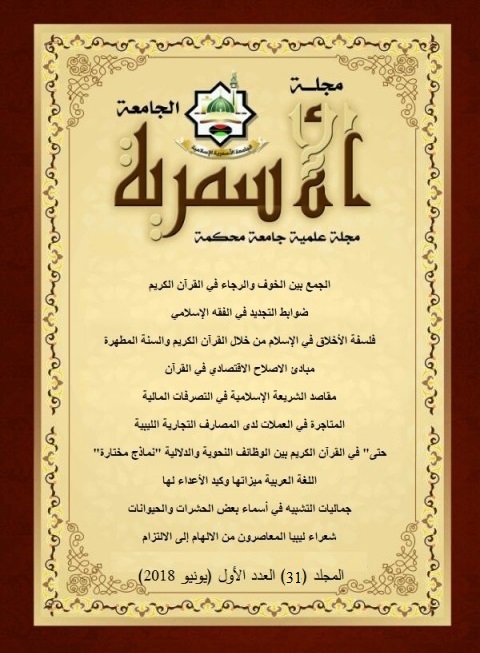ملاطات البوزولان (Pozzolan) في مباني الفيلات الرومانية بإقليم المدن الثلاث في ليبيا
DOI:
https://doi.org/10.59743/jau.v31i1.1368الملخص
تسلط هذه الدراسة الضوء على الاستخدام التقني الإنشائي لمواد البوزولان، التي استخدمها البناءون، وتقنيو الفسيفساء الرومان خلال القرن الثاني الميلادي، في إعداد ملاطات أرضيات، وجدران مباني الفيلات الرومانية المكتشفة في الجزء الشمالي الغربي من الساحل الليبي، ضمن النطاق الجغرافي لما كان يُعرف قديماً بـ إقليم المدن الثلاث خلال العصر الروماني، حيث بيّنت الدراسة الميدانية لعينات الملاط، وكذلك المعملية باستخدام تقنيات التحليل العلمية الحديثة المتمثلة في: تحليل النسيج الصخري(التحليل البتروغرافي)، وتحليل حيود أشعة أكس، ملامح الاستخدام الإنشائي المتنوع لمواد البوزولان ضمن ملاطات بعض العناصر الفنية المعمارية، ضمن مباني الفيلات، وذلك بما يكفل لها خاصيتا تماسك، وديمومة، وفق المتطلبات الإنشائية لهذه العناصر على مر العصور والأزمان.
المراجع
-Pliny, Natural History, Books 33-35, With an English Translation By H.Rackham, Loeb Classical Library, Harvard University Press, First Published, Cambridge- Massachusetts, London, England, (1952)
-Pliny, Natural History, Books 36-37, With an English Translation By D.E.Eichholz, Loeb Classical Library, Harvard University Press, First Published, Cambridge- Massachusetts, London, England, (1962)
-Vitruvius, On Architecture, Books 1-5, Edited And Translated By Frank Granger, Loeb Classical Library, Harvard University Press, First Published, Cambridge- Massachusetts, London, England, (1931)
-Vitruvius, On Architecture, Books 6-10, Edited And Translated By Frank Granger, Loeb Classical Library, Harvard University Press, First Published, Cambridge- Massachusetts, London, England, (1934)
-Vicat, L.J, Mortars And Cements, Translated By J.T.Smith, Donhead Publishing Ltd, Printed in Great Britain By Redwood Books Ltd, Trowbridge, (1997)
- القسم الفني (1976)،"التقرير الفني حول الاكتشاف الأثري بمنطقة الدافنية"، مراقبة آثار لبدة- ليبيا.
- النمس، محمود عبد العزيز(1968) ،"حفائر مصلحة الآثار في تاجوراء"، مجلة ليبيا القديمة، المجلدان الثالث والرابع 1960-1967، وزارة السياحة والآثار- مطابع ج. باردي، روما.
- بن جمعة، محمد عبد الحفيظ و بن رابحة، خيري عبد السلام (2000) ، "التقرير الفني حول حفرية فيلا وادي لبدة"، القسم الفني بمراقبة آثار لبدة، مصلحة الآثار، الخُمس- ليبيا.
بن مسعود، أمحمد الهادي (2000)، دليل متحف آثار زليتن، الإدارة العامة للبحوث الأثرية والمحفوظات التاريخية، دار الكتب الوطنية، الطبعة الأولى، بنغازي – ليبيا.
- دي فيتا، أنطونيو(1966)، "حفريات الفيلا الرومانية بساحل تاجورة"، مجلة ليبيا القديمة، المجلد الثاني، الادارة العامة للآثار والمتاحف والمحفوظات التاريخية بليبيا، مطابع ج. باردي، روما.
- نامو(2009)، مصطفى علي محمد، دراسة أثرية لفسيفساء أرضيات بعض الدارات في منطقة المدن الثلاث، المركز الوطني للمحفوظات والدراسات التاريخية، الطبعة الأولى، دار الكتب الوطنية،بنغازي.
-Aurigemma, Salvatore (1960), L’Italia in Africa - Le Scoperte Archaeologiche (1911-1943)-Tripolitania - I Mosaici, Parte Prima, Instituto Poligrafico Dello Stato, Stampoto in Italia,Rome.
- Adam, Jean – Pierre (1999), Roman Building – Materials and Techniques, Translated by Anthony Mathews, Routledge – Taylor and Francis Group, First Published, London and New York.
-Branda, F., Costantini, A., Luciani, G. and Piccioloi, C. (2000), “A Note on Incrustations on a Mosaic Floor Fragment from Punta Epitaffio in Baia”, Studies in Conservation, Vol. 45, No. 3, P. 212, International Institute for Conservation of Histroic and Artistic Works, JSTOR. DOI: https://doi.org/10.2307/1506767
-Fagan, Brian M. (2007), Discovery-Unearthing the New Treasures of Archaeology, Thames and Hudson Ltd, First Published, London.
-Griswold, John and Uricheck, Sari )1998(, “Los Compensation Methods for Stone”, Journal of the American Institute for Conservation, Vol 37, No. 1, P. 96, The American Isntitute for Conservation of Historic and Artistic Works, JSTOR.
-Giavarini, Carlo (2010), “The Basilica Of Maxentius and Its Construction Materials, Materials – Technologies and Practice in Historic Heritage Structures”, Springer Science + Business Media B.V, Edited By Maria Bostenaru and Richard Prikry and Atos Torok , Printed in Berlin, Germany. DOI: https://doi.org/10.1007/978-90-481-2684-2_12
-Griswold, John and Uricheck, Sari (1998), “Los Compensation Methods for Stone”, Journal of the American Institute for Conservation, Vol 37, No. 1, P. 96, The American Isntitute for Conservation of Historic and Artistic Works, JSTOR. DOI: https://doi.org/10.1179/019713698806082912
-Joshi, R.C. and Lohtia , R.P. (1991), Fly Ash in Concrete Production, Properties and Uses, Advances in Concrete Technology, Volume 2, Gordon, and Breach Science Pubishers, Printed in India.
-Kozlowski, Roman, Hughes, David and Weber, Johannes (2010), “Roman Cements: Material of the Built heritage of the 19th Century, Edited By Maria Bostenaru and Richard Prikry and Atos Torok , Springer Science + Business Media B.V, Printed in Berlin, Germany. DOI: https://doi.org/10.1007/978-90-481-2684-2_14
-King.P.E., Bruce (2005), Making Better Concrete - Guidelines to Using Fly Ash for Higher Quality Eco - Friendly Structures, Green Building Press, USA.
-Kirca,O.(2005),Ancient Binding Materials, mortars and concrete technology: history and durability aspects, Structural Analysis of Historical Construction-Modena, Lourenco & Roca(eds),Taylor & Francis Group, London, ISBN.
-Malhotra, V.M. and Mehta, P. Kumar (1996), Pozzolanic and Cementitious Materials, Advances in Concrete Technology, Volume 1, Taylor and Francis Group, Printed in The United Kingdom by Lightning Source Uk Ltd.
-Nawrocka, Danuta, Goslar,Tomasz and Pazdur, Anna (2010), “Historic Mortars and plaster as a Material for age Determination, Springer Science + Business Media B.V, Edited By Maria Bostenaru and Richard Prikry and Atos Torok , Springer Science + Business Media B.V, Printed in Berlin, Germany. DOI: https://doi.org/10.1007/978-90-481-2684-2_15
-Searle, Alfred B. (1914), Cement - Concrete And Bricks, Outlines of Industrial Chemsitry, D. Van Nostrand Co, New York.
-Porter, Mary Winearls (1907),What Rome Was Build With: Aescription of the Stones Employed in Ancient times for it’s Building, BiboloBazaar. LLC, London.
-Rech, Jason A. (2004), “New Uses for Old Laboratory Techniques”, Near Eastern Archaeology, Vol. 67, No.4, PP. 212,213,216, The American Schools of Oriental Research, JSTOR. DOI: https://doi.org/10.2307/4132388
-Searle, Alfred B. (1914), Cement - Concrete And Bricks, Outlines of Industrial Chemsitry, D.Van Nostrand Co, New York.
-Velosa, Ana Luisa, Veiga, Rosario, Coroado, Joao, Ferreira, Victor M. and Rocha, Fernando (2010), “Characterization of Ancient Pozzolanic Mortars from Roman Times to the 19th Century: Compatibility Issues of New Mortars with Substrates and Ancient Mortars, Materials- Technologies and Practice in Historic Heritage Structures”, Springer Science + Business Media B.V, Edited By Maria Bostenaru and Richard Prikry and Atos Torok, Printed in Berlin, Germany. DOI: https://doi.org/10.1007/978-90-481-2684-2_13
-Wendowski, Marlies and Ziegert, Helmut(2007), “The WadiLebda Roman villa- Roman- Libyan Mosaics”, MINERVA- The International Review of Ancient Art and Archaeology, Vol. 16, No. 6, Aurora Publications Ltd, London
-Ziegert, Helmat(2002), “Loess over Lebda- A preliminary report of Investingations 1999-2002”, HEPHAISTOS- New Approaches in Classical Archaeology and related fields 1999 -2002, Camelion- Verlag / Mering Augsbury.
التنزيلات
منشور
كيفية الاقتباس
إصدار
القسم
الرخصة
الحقوق الفكرية (c) 2018 د. مصطفى علي نامو، علي بشير الهدار

هذا العمل مرخص بموجب Creative Commons Attribution 4.0 International License.
تتعلق الحقوق بنشر وتوزيع البحوث المنشورة في مجلة الجامعة الأسمرية، حيث توضح للمؤلفين الذين نشروا مقالاتهم في مجلة الجامعة الأسمرية، كيفية استخدام أو توزيع مقالاتهم، والاحتفاظ بجميع حقوقهم في المصنفات المنشورة، مثل (على سبيل المثال لا الحصر) الحقوق التالية:
- حقوق الطبع والنشر وحقوق الملكية الأخرى المتعلقة بالمقال المقدم، مثل حقوق براءات الاختراع.
- استخدام البحث المنشور في مجلة الجامعة الأسمرية في الأعمال المستقبلية الخاصة بالمؤلفين، بما في ذلك المحاضرات والكتب، والحق في إعادة إنتاج المقالات لأغراضهم الخاصة، والحق في الأرشفة الذاتية لمقالاتهم.
- الحق في الدخول في مقال منفصل، أو للتوزيع غير الحصري لمقالاتهم مع الإقرار بنشره الأولي في مجلة الجامعة الأسمرية.
الحقوق الفكرية: وفق الرخصة الدولية للأعمال الإبداعية المشاعة، النسخة 4.0.
بيان الخصوصية: سيتم استخدام الأسماء وعناوين البريد الإلكتروني التي تم إدخالها في موقع مجلة الجامعة الأسمرية للأغراض المذكورة فقط والتي استخدمت من أجلها.










